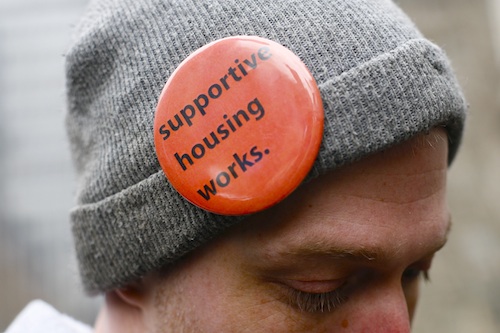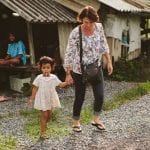By Kate Bristol
Consider these scenarios: a young man with a serious mental illness is ready to move from a group home to independent living in the community, but must find a housing unit he can afford on a $640 per month disability benefit. A women with two small children flees her abusive spouse and must not only find a safe place to live, but must also figure out how to move from welfare benefits to a steady job before her two years of eligibility run out. A man who has been chronically homeless for years due to substance abuse has just successfully completed drug treatment and obtained a minimum wage job, but must find not only affordable housing but also a support system to prevent him from relapsing.
In each of these cases, the key to ensuring that each of these individuals obtains and maintains a stable housing situation is supportive housing, a relatively new approach to housing people with special needs.
Supportive housing is extremely low-cost housing linked with social services that are provided either on-site or elsewhere in the community. It is targeted in particular to individuals who have chronic mental illness, are living with HIV or AIDS, are fleeing domestic violence, have a physical or developmental disability, or who are recovering substance abusers.
While supportive housing has been around since the 1960s, the term first became widely known among housing professionals in 1987, when the U.S. Department of Housing and Urban Development created the Supportive Housing Demonstration Program to fund transitional and permanent supportive housing for homeless individuals and families. In the last decade, hundreds of nonprofit and government agencies have sprung up that specialize in developing, acquiring, and managing supportive housing. They also benefit from financial support, technical assistance, and advocacy from a number of intermediary organizations, such as the New York-based Corporation for Supportive Housing.
There are two components to successful supportive housing development: deep housing subsidies that make units affordable to people living on public benefits or very low wages, and easily accessible services designed to help residents maintain stability and prevent the recurrence of homelessness.
The importance of the level of subsidy becomes clear when considering the purchasing power of individuals who earn $6,000 to $12,000 per year, the typical income of people working full-time at minimum wage or receiving Supplemental Security Income (SSI) or Temporary Assistance for Needy Families (TANF — more commonly known as welfare). For most households with these income sources, virtually the entire market-rate housing stock is out of reach. According to the Low Income Housing Coalition, “in 49 states and 357 metropolitan areas, the entire maximum family TANF grant level does not fully cover the fair market rent in that area.”
Unfortunately, the situation is almost as bad in the subsidized housing supply. The majority of affordable housing complexes developed by the non-profit sector are simply too expensive for families in these income ranges. Even a typical rent of $400 or $500 for a one-bedroom unit in an affordable housing complex is out of reach for a women earning $480 per month on TANF. Generally these households require a rent structure that allows them to pay a percentage of their income (typically 30 percent) for rent. Under this approach, a typical SSI recipient will pay about $180 out of a $640 monthly income for rent. This approach helps insulate residents from loss of housing as a result of unexpected changes in their incomes.
This lack of affordability in “affordable” housing does not reflect a lack of effort on the part of non-profit providers. Rather, it reflects the tremendous difficulty non-profits face in trying to secure sufficient funding to create units at rents affordable to individuals earning 25 percent of area median or below. Most of the major federal and state funding sources for affordable housing, such as low-income tax credits, target households that earn at least 50 percent of median income.
There are only a few federal funding streams that provide sufficient capital and operating subsidy to allow developers and owners to set rents at 30 percent of a resident’s income. These include the Supportive Housing Program; Section 202 and 811 programs, which provide funds for seniors and younger disabled people, respectively; and Section 8 programs. Traditional public housing, operated by local housing authorities, also offers units at 30 percent of a resident’s income. Though public housing was never intended to be a form of supportive housing, it is one of the only forms of subsidized housing affordable to homeless people and those with special needs. Housing authorities are increasingly finding themselves in the position of having to learn how to deliver supportive services to public housing residents.
Not surprisingly, these sources of funding for supportive housing are hopelessly inadequate to meet the need. Only one in three renter households living below the poverty line receives housing assistance. In the last ten years funding for these programs has either remained flat or suffered cutbacks. This creates a situation in which non-profits specializing in supportive housing increasingly have to compete against each other for pieces of an ever-shrinking pie.
Securing a subsidized unit does not by itself solve the housing problems of many homeless individuals or others with special needs. The majority of chronically homeless individuals, particularly those with mental illness and/or substance abuse problems, often succeed in obtaining subsidized housing but are evicted due to a relapse of substance use or failure to regularly take prescribed psychiatric medication. Typically they then become homeless, require costly emergency services, enter expensive residential treatment programs, or become institutionalized, and then face discharge into permanent housing that does not provide the support they need to maintain a stable living situation.
Supportive housing succeeds in breaking this cycle by ensuring that residents receive accessible, responsive, flexible services designed to help them maintain their housing. These forms of assistance can include medical care, mental health services, substance abuse treatment, job training, child care, and independent living skills training. Hundreds of innovative non-profit agencies and government organizations have demonstrated the success of the supportive housing model. Each takes a unique approach to meeting the particular needs of their residents.
In Chicago, the Lakefront SRO Corporation operates 685 single-room occupancy (SRO) apartments targeted to homeless single individuals. The majority of the residents have an addiction problem, are in recovery, or have another disability. Lakefront uses a “blended management” system that integrates property management and social services such as case management, employment assistance, and recreational activities. Residents pay 30 percent of their income for rent, with $108 the average monthly rent. Most of these units were created using the Section 8 Moderate Rehabilitation Program, which provides an ongoing operating subsidy to cover the difference between the resident rents and the cost of operating the complexes. Like many other forms of subsidy for supportive housing, the Section 8 Mod program is now virtually unavailable for new projects.
In San Francisco, four different supportive housing complexes (Canon Kip, the Lyric, the Rose Hotel and Cambridge & Hemline) are participating in an innovative initiative to bring integrated services to 300 formerly homeless residents. With the assistance of the Corporation for Supportive Housing’s Health, Housing and Integrated Services program, these complexes are able to offer residents access to a multi-agency team of professionals offering services ranging from primary medical care to assistance with daily living skills.
These examples provide permanent supportive housing. Most residents have such serious disabilities that they will likely require some level of supportive services for their entire lives in order to remain independent. However, there are some groups of people with special needs that require only interim housing assistance and supportive services. These include many families receiving TANF, women fleeing domestic violence, and some individuals with substance abuse problems.
Phipps Houses in the Bronx is but one of hundreds of groups nationwide that operates transitional supportive housing programs. At the organization’s Lee Goodwin Residence, formerly homeless women and their children may live in a subsidized unit for up to two years while they formulate a plan for self-sufficiency. On-site services include job skills assessment, vocational counseling, parenting workshops, support groups, and linkages to job training programs. The program is designed to ensure that residents learn the skills they need to become independent of public assistance.
These are solutions that work. They represent creative approaches to the problem of providing housing to the most fragile individuals and families in our communities. All that is needed at this time is the political will to fund replication of supportive housing complexes wherever they are needed.
Kate Bristol is Senior Program Manager for Supportive Housing at the Marin County Housing Authority.







